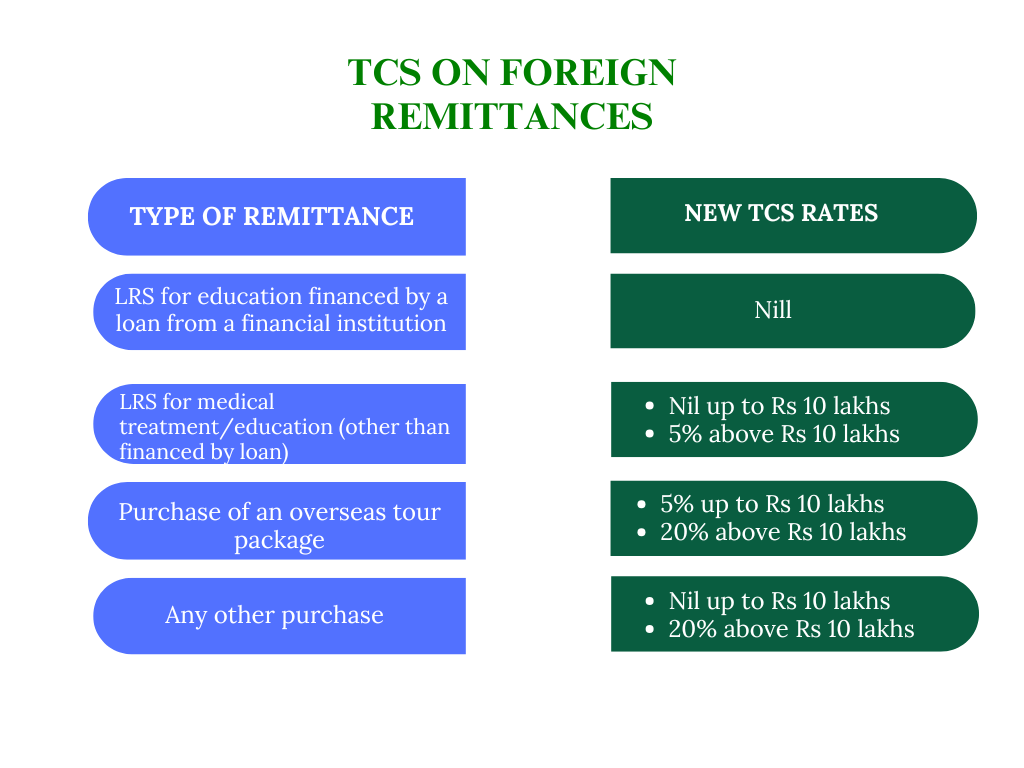TCS on Foreign Remittances in India in 2025
When someone sends money outside India, they need to collect tax at the source or TCS and submit it to the Income Tax Department of the country. This is called TCS on Foreign Remittances, and it aims to reduce cases of tax evasion and promote transparency. Even in the 2025 budget announcement, the threshold limit for the TCS on foreign remittances has been increased to benefit the taxpayers. This article contains details about the tax collected at the source on foreign remittances, exemptions, and deductions available under the new tax regime in 2025.

What is the Liberalized Remittance Scheme?
Under the LRS scheme, all resident individuals are allowed to remit up to USD 250,000 per financial year outside India. And TCS on foreign remittances or foreign exchange transactions applicable to resident Indians under LRS was introduced in the Finance Bill 2020.
All such transactions are classified as either capital or current account transactions under the Foreign Exchange Management Act, 1999. All transactions that do not alter the assets or liabilities, including contingent liabilities by a resident outside India, are current account transactions.
Tax on Foreign Remittances
The below-mentioned tax rates on particular types of remittances will come into effect from the 1st of April 2025.
| Type of Remittance | New TCS Rates |
| LRS for education financed by a loan from a financial institution | Nil |
| LRS for medical treatment/education (other than financed by loan) | Nil up to Rs 10 lakhs 5% above Rs 10 lakhs |
| Purchase of an overseas tour package | 5% up to Rs 10 lakhs 20% above Rs 10 lakhs |
| Any other purchase | Nil up to Rs 10 lakhs 20% above Rs 10 lakhs |
For example, suppose you want to make an investment worth Rs 15 lakhs in a foreign country, and there is no TCS up to Rs 10. Therefore, you have to pay TCS on the spare amount of Rs 5 lakhs at the rate of 20%, which is Rs 1,00,000. On an investment of Rs 15 lakhs, you have to pay Rs 16 lakhs, including TCS.
How to Save Taxes on Foreign Remittances?
20% TCS on remitting money to foreign remittances is quite exorbitant however, there are several options available to save taxes.
- Maintain the basic exemption limit
Whenever remitting the payment overseas, keep the amount below the basic exemption limit in each financial year. The basic exemption limit in 2025 is Rs 10 lakhs.
- Education and medical treatments
5% TCS applies to expenses incurred on education or medical treatment of your spouse, child, or parent, and if such expenses are incurred through a loan, then only 0.5% TCS.
- Spending through Credit cards
No TCS on expenses by foreign credit card till the basic exemption limit.
- On the usages of NRI account
In case you or your family owns an NRI account, no TCS is applicable on outward remittances, and it is a completely legal option.
How to Keep a Check on TCS Deductions?
Form 27D: issued by TCS dealers as a proof that tax at source is collected and deposited to the tax authorities
Form 26AS: a tax credit statement containing details about TDS and TCS deducted or collected against your PAN and available on the income tax e-filing portal.
Other Statements: The annual information statement (AIS) and tax information statement (TIS) available on the income tax e-filing portal give confirmation about the TCS deducted from your transfers.
You can also claim a TCS refund on foreign remittance as the TCS collected by the bank or service provider is deposited to the government and is available as a tax credit on your income tax return. When you file an ITR and your total liability is less than the TCS deducted, then you can claim the refund.
Reach out to TaxDunia to claim your refunds and meet the compliance. Our team will handle all the paperwork while you can focus on growth and creating value.

